The following blurb is an artist statement that accompanied the exhibition: The system has no memory at Board of Directors in July 2009.
“An infinite number of sentences can be generated from a finite number of words which undergo a finite number of transformations of order.”
Noam Chomsky’s First Principle of Transformational Grammar
This is an artist statement. As such, it should be regarded skeptically. This should not be mistaken for a declaration of meaning. Rather, it is a clarification of intention. Meaning belongs to the spectator. To complicate this notion: Sartre once said, “Paintings don’t mean anything, but they have meaning.” Despite the uncomfortable fact that I’ve now cited Sartre in my artist statement, the quotation itself is compelling and conveys my thoughts on the subject of meaning in my work.
I used to be an abstract painter. While always acknowledging, and in fact courting, the idea that my interior condition was not virginal terrain, that the things within us are always filtered through the lens of memory and experience, the specific shapes within my work were always of my own invention. These works acquired meaning, I think, through a sense of “looks-like”, phenomenological resemblance. This tenuous relation caused a crisis for me, and I started to think about a different approach.
Inspired by an essay of Yves-Alain Bois on the work of Ed Ruscha, I started taking pictures of the “visual noise” in my surrounding landscape: paint spills, billboards, magic-marker-graffiti-tags, product packaging, etc. Most of these photographs were taken where I lived (at Yonge and Eglinton), and where I worked (in Regent Park). I then started tracing these shapes, projecting and layering them onto my canvas. Projecting was important because I felt this process maintained the integrity of the appropriated form. It wasn’t my interpretation of that shape. It was that shape. Whatever went on inside their contours and how they fit together was my domain of creative play. All of the titles for my work came from spam emails. They still do. The title for this show also comes from spam. And so meaning has, or so it is intended, shifted more to my works epistemology. But the longer you work with something, the more complex it becomes.
For the first year, I added more and more shapes to my inventory. I ended up with 102. I’ve been making my work with the same shapes ever since. They are my vocabulary of forms. This language is not necessarily closed, however, like any other language, its terms are predicated by need. I have, thus far, not needed any more. There is no specific reason for 102, but it’s better than 101. Language needs structure, and so I have become increasingly concerned with the structures that I place my vocabulary into: art historical and pop cultural formal structures and conventions.
I’ve never been one to paint the same thing over and over again. Perhaps this is shooting myself in the foot as it complicates the likelihood of easy branding. But a painting for me is a proposition: a can this thing actually happen? Sometimes it can. Sometimes it can’t. A really great painter once told me, “You don’t have to reinvent the wheel every time you paint.” But in my case, I think that’s entirely the point: my work is about reinvention, or at least reuse and repositioning. I know that’s not what he meant. But it’s what I’ve taken.

video footage from Sudden Frost at Elissa Cristall, Vancouver
Will Gorlitz at Michael Gibson Gallery

John Eisler at Diaz Contemporary

Michel Daigneault at AKAU

No comments:
Post a Comment